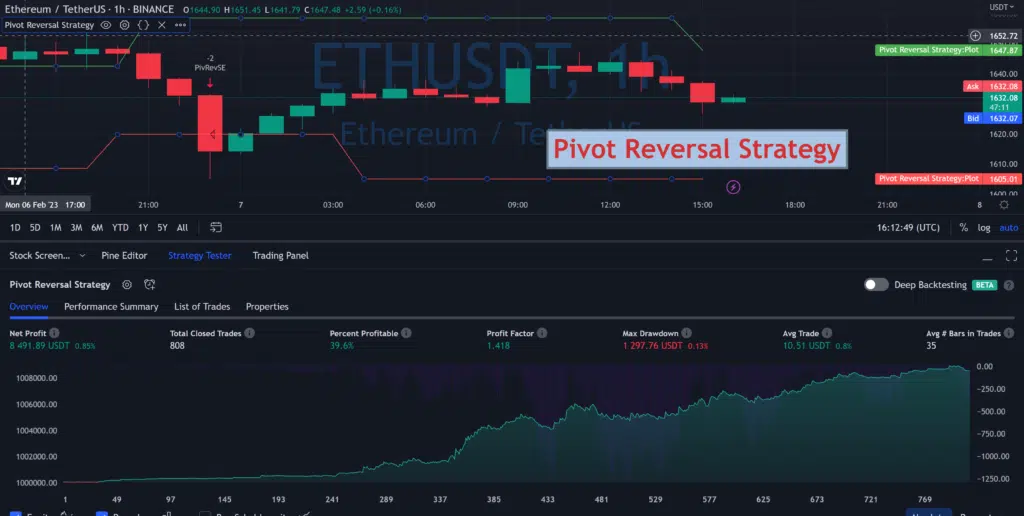The pivot reversal strategy is a popular trading strategy for crypto. It is based on the principle of buying or selling when the price of an asset hits a certain level, signaling a possible reversal in its trend. This strategy can be used to capitalize on short-term price movements in crypto markets. So I decided to implement it in Python with the help of vectorbt framework.
First let’s import libraries needed in our development:
import pandas as pd
import vectorbt as vbt
import numpy as np
import datetime
Next, we need to load data. I’m loading data from my data warehouse, but you can use any other data source. In my blog, I have many articles with examples of how to load bars from Binance, ByBit, and EOD for stocks for example. For his example, I’m using 1h data for ETHUSDT from 2020:
data_hist = pd.read_parquet("/data/binance/spot/1h/ETHUSDT.parquet")
data = data_hist[data_hist.index > datetime.datetime(2020, 1, 1)].copy()
Next, I’ll specify the parameters needed for Pivot Points. I need to set only left, and right bars, and also I’m using min tick because I’m using it in setting stop/limit orders.
left_bars = 5
right_bars = 5
min_tick = 0.0001
Next, let’s do the needed computations. For simplicity and speed, I’m doing everything in numpy and pandas. Next, let’s compute our pivot points. In total, we’ll have 4 variables:
- shw_cond – true/false where swing high is happening
- shl_cond – true/false where swing high is happening
- hprice – last swing high price
- lprice – last swing low price
Calculations are pretty simple. We just compare the highs/lows of the current bar with the needed amount of highs/lows around it.
# Swing High, Condition and hprice
data["swh_cond"] = (data.high >= data.high.rolling(left_bars).max().shift(1)) & \
(data.high >= data.high.rolling(right_bars).max().shift(-right_bars))
data["hprice"] = np.where(data['swh_cond'], data.high, np.nan)
data["hprice"] = data["hprice"].fillna(method='ffill').shift(right_bars).fillna(value=0)
# Swing Low, Condition and lprice
data["swl_cond"] = (data.low <= data.low.rolling(left_bars).min().shift(1)) & \
(data.low <= data.low.rolling(right_bars).min().shift(-right_bars))
data["lprice"] = np.where(data['swl_cond'], data.low, np.nan)
data["lprice"] = data["lprice"].fillna(method='ffill').shift(right_bars).fillna(value=0)
Next, let’s compute signals themselves as crossovers of high/low and recent pivot high/low levels:
# Long crossover
data["Long entries"] = (data.high >= data.hprice.shift(1) + min_tick) & (data.high.shift(1) < data.hprice.shift(2) + min_tick)
# Short crossover
data["Short entries"] = (data.low <= data.lprice.shift(1) - min_tick) & (data.low.shift(1) > data.lprice.shift(2) - min_tick)
In vectorbt we’ll simulate stop orders, so we need to save the price at wich I want to execute my orders. We’ll create a separate column for it:
data["trade_price"] = np.where(data["Long entries"], \
data.hprice + min_tick, \
np.where(data["Short entries"],data.lprice - min_tick, np.nan))
Now we have everything ready to calculate our strategy using vectorbt engine:
pf = vbt.Portfolio.from_signals(
data.close,
entries=data["Long entries"],
short_entries=data["Short entries"],
upon_opposite_entry="ReverseReduce",
price=data["trade_price"],
freq='1h'
)
Out backtest is computed, so now we can output some statistics. stats() method will output the main metrics for our strategy:
pf.stats()
Start 2020-01-01 01:00:00 End 2023-02-06 23:00:00 Period 1131 days 16:00:00 Start Value 100.0 End Value 24143.734197 Total Return [%] 24043.734197 Benchmark Return [%] 1135.6782 Max Gross Exposure [%] 100.0 Total Fees Paid 0.0 Max Drawdown [%] 37.005134 Max Drawdown Duration 136 days 17:00:00 Total Trades 809 Total Closed Trades 808 Total Open Trades 1 Open Trade PnL 82.733924 Win Rate [%] 39.727723 Best Trade [%] 56.521998 Worst Trade [%] -12.492299 Avg Winning Trade [%] 5.626995 Avg Losing Trade [%] -2.3353 Avg Winning Trade Duration 2 days 05:04:51.588785046 Avg Losing Trade Duration 0 days 20:44:06.406570841 Profit Factor 1.422016 Expectancy 29.654703 Sharpe Ratio 2.460286 Calmar Ratio 13.156512 Omega Ratio 1.083777 Sortino Ratio 3.658924
If we’ll compare this with the output of PineScript for the same period/instrument/timeframe, we’ll see that we’re quite close:

To plot a nice chart you can use plot() method on our backtest object:
pf.plot()

To see trade-by-trade statistics you can use pf.positions.records_readable output. This will output us a nice data frame with all the trades:
pf.positions.records_readable

Follow me on TradingView and YouTube.







